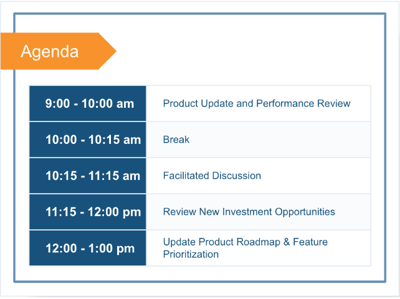Maximizing Success: The Power of Quarterly Product Reviews

Quarterly product reviews are a critical component of an organization's product strategy. They provide an opportunity to assess the performance of the product portfolio, evaluate new product ideas, and make informed decisions about resource allocation. Additionally, QPRs hold teams accountable, ensure alignment across the organization, and help prioritize the right ideas in the pipeline.
Without these reviews, organizations risk making these common mistakes:
- Roadmaps can be misaligned with your productization strategy. It can be easy to lose sight of the larger product vision and strategy. This leads to a misalignment between your product roadmap and goals, resulting in wasted resources and missed opportunities.
- Lack of accountability can lead to missed outcomes, especially the desire to go too big too soon. Team members can become complacent and lose sight of their responsibilities.
- Designing and developing in a vacuum. This results in products that don't meet the market's needs or solve urgent and expensive customer problems.
- Unclear prioritization. Team members can drift to working on things that aren't a priority or are not aligned with your productization goals.
Whether you are a company just starting to productize or with an established product portfolio, your team should review product performance regularly. These reviews, typically led by a product leader, bring together product managers to share performance updates and involve company leaders and stakeholders with a say in decision-making.
As part of our Spark Productize Pathway® Program, we co-facilitate Quarterly Product Reviews with our members. Together, we review the latest data and customer feedback, market trends, and sales performance to determine the strengths and weaknesses of each product in their portfolios. The insights gained from these reviews drive:
- Product improvement and innovation
- Enhance customer satisfaction
- Increase profitability
- Free up resources to focus on higher-performing products
- Make confident decisions about the future of their product portfolio.
In this article, we will provide tips on how to prepare for a successful quarterly product review. You’ll learn:
- What is a Product Review?
- Why is it important?
- Who should participate?
- How do you prepare?
What is a Product Review? Why are they important?
Quarterly product reviews are a valuable tool for businesses of all sizes, whether they are just starting to productize or have a well-established product portfolio. Product Reviews are typically a half-day or a 2-4 hour meeting held quarterly to assess the overall performance of a company's product portfolio. These reviews aim to evaluate the performance of all new products using the same measures and iteratively prioritize future investments of time, talent, and resources. Also, new product or feature ideas are discussed to determine which ones to pursue.
The result of the review is a clear product portfolio, roadmap, or plan of action that aligns with the company's productization goals and a better understanding of what stakeholders can anticipate now, next, and later. The quarterly product review bridges the gap between the early planning stage when the product vision is vague and complex, and the later stages, when all the details are laid out.
Who should attend?
A product leader typically leads the review process in the organization, and product managers are responsible for reporting on their product’s performance. Stakeholders also attend to provide input and make decisions on the product strategy.
It is important that the entire team comes together and assesses the product portfolio to ensure that their product strategy is aligned with their overall business objectives.
How you identify key stakeholders is critical for success; this group should include company leaders, product managers, and anyone else whose buy-in and input will be needed for decisions about products. It’s important to not only select the right team but also ensure that they are aware of the agenda and their role in the process.
To ensure the right mix of experience and perspectives, a QPR will include a leader/member from each of the following teams:
-
Executive: to provide strategic guidance & ensure the product aligns with the overall business goals
-
Product: to provide an update on the product's progress and future plans
-
Development (including Software engineers and designers): to provide an update on the technical aspects of the product and discuss any challenges they are facing
-
Marketing/Sales: to provide insight into the market and customer needs and discuss the product's sales and marketing strategy
-
Customer Success: to provide feedback from customers and discuss customer support issues
-
Operations: to discuss operational challenges and ensure the product is being manufactured and distributed efficiently
-
Quality Assurance: to discuss any quality issues and ensure the product meets customer expectations
What does it cover?
The standard agenda for a half-day Product Review is as follows:
-
Product Update and Performance Review: Here, participants review the performance of products across the portfolio. Before the meeting, the product scorecard is updated to show the performance of each product against key metrics (see how to create a scorecard below). The product owner presents the results of their product, followed by a facilitated discussion.
-
Facilitated Discussion: This discussion covers what is working and not working, and product owners are asked questions about performance for clarification.
-
Review New Investment Opportunities: Next, new product ideas or investment opportunities are reviewed. This includes evaluating and mapping new opportunities based on your scoring model. We suggest using the RICE model or Value-Complexity Matrix (see more details below).
-
Update Product Roadmap: Finally, the product roadmap is updated based on the discussion, reflecting insights and decisions made during the review. This structured approach to product reviews ensures that all products are evaluated consistently, that all relevant stakeholders are engaged, and that the company's product strategy remains aligned with its goals.
Here is a snapshot of the agenda Vecteris uses for facilitating half-day Quarterly Product Reviews:

How do you prepare?
Preparation is key when it comes to conducting effective and productive quarterly product reviews. Here are the steps you need to take to prepare to make informed decisions about resource allocation across the portfolio.
-
Define the business goals for the next quarter: Company and team goals change over time, so ensure your business goals for the next quarter align with your organization's current needs.
-
Update the product scorecard: The product scorecard summarizes the performance of each product using the same metrics. Before the review, update the scorecard to reflect each product's current performance accurately. Gather data and insights from product managers, customer support teams, and sales teams to build a comprehensive view of the product portfolio and help inform the discussion about future investments. (See below for more on product scorecards)
-
Identify bottlenecks or resourcing needs: Collect a high-level estimate of costs and resourcing needs to ensure understanding and timely communication between stakeholders and product teams. Everyone must be clear on WHAT the product solves for customers and WHY it was prioritized or has potential for a business impact.
-
Update your high-level roadmap: After the estimates and priorities are clear, it's a good idea to update the roadmap in real time with stakeholders. This will help stakeholders align with your team's goals and form realistic expectations.

Use a Scorecard to Evaluate Existing Products & Feature Usage
An effective way to evaluate the performance of your products or features is to create a scorecard. This tool helps you consistently measure and assess performance using the same key metrics, giving you an accurate and objective view of each product or feature's performance. By regularly reviewing this scorecard, you can make informed decisions about where to allocate resources and prioritize development, ensuring that your product portfolio aligns with your overall business goals.
As part of their Spark Productize PathwayTM Program, we helped Culture Partners to build a product scorecard for portfolio reviews. Culture Partners, formerly Partners in Leadership, helps thousands of top organizations realize their potential by harnessing the power of culture. To pursue a productization strategy, they needed to align their Product and Delivery teams around a shared product vision and standardized approach. As a result of the program, the Culture Partners team aligned on objective criteria for evaluating and prioritizing new ideas, using a quarterly process to review portfolio performance, allocate resources, and adjust roadmaps.
Here’s an example of a scorecard that compares two products using the same key metrics.
-
Revenue compared to plan
-
Margin, compared to the previous quarter or time period
-
Usage, by the user and by account
-
CSAT (Client Satisfaction Score)
-
Pipeline

Not having all the data needed for a product review can be challenging, but it's not insurmountable. Here are some ideas for organizations that don't have the data they need:
-
Conduct User Research: Conduct user research to gather qualitative data on user needs, preferences, and pain points.
-
Focus on Non-Financial Metrics: Focus on non-financial metrics such as customer engagement, usage patterns, and feedback to evaluate product performance.
-
Collaborate with Other Departments: Collaborate with other departments, such as customer support, sales, and marketing to gather customer interactions and feedback data.
-
Ask for Feedback: Ask customers and users for feedback on the product and usage patterns.
While not having all the data needed for a product review can be challenging, organizations can gather the information they need to make informed decisions and improve their product offerings by using these ideas.
In today's fast-paced business environment, Quarterly Product Reviews play a crucial role in the success of a product and the organization as a whole. Regular reviews allow organizations to assess the performance of their products, gather valuable insights, align on the product's vision and strategy, and make informed decisions for future development across a complex portfolio of opportunities. Through regular product reviews, organizations can stay on top of their products' performance and identify opportunities for improvement. Additionally, by involving cross-functional teams in the review process, organizations can ensure that all perspectives are considered and that the product is aligned with the overall goals and strategy of the organization. By conducting quarterly product reviews, organizations can ensure the success of their products and achieve their goals.
Our Productize Pathway® Advisory Solution will teach you how to prepare and facilitate Quarterly Product Reviews to establish a discipline for creating and managing products quickly using a market-oriented approach. This is essential in laying a foundation for a product-friendly culture that demonstrates innovation-supporting behaviors. If your organization is shifting towards a product-led orientation, we’d love to talk! Contact us today to learn more.
